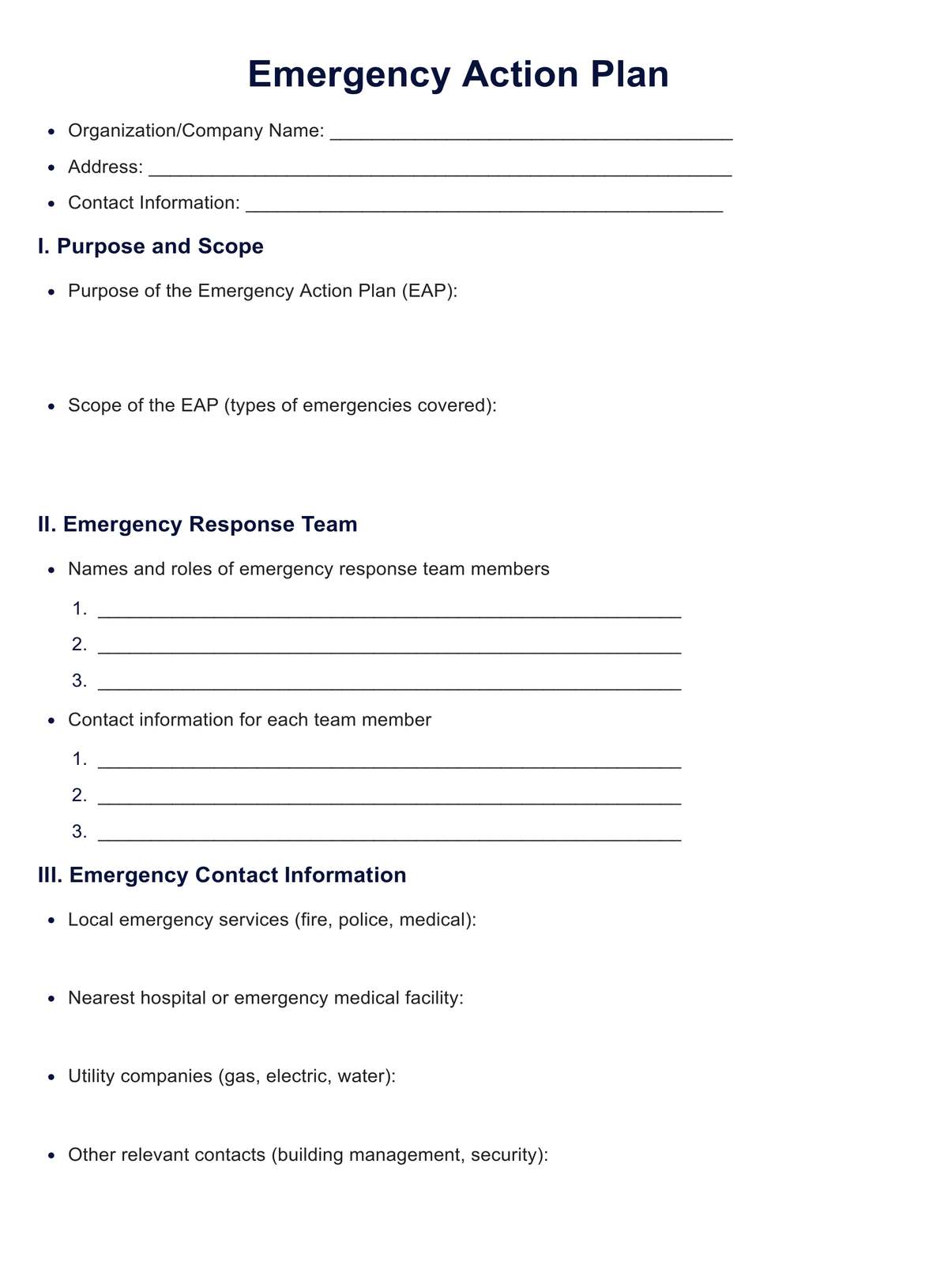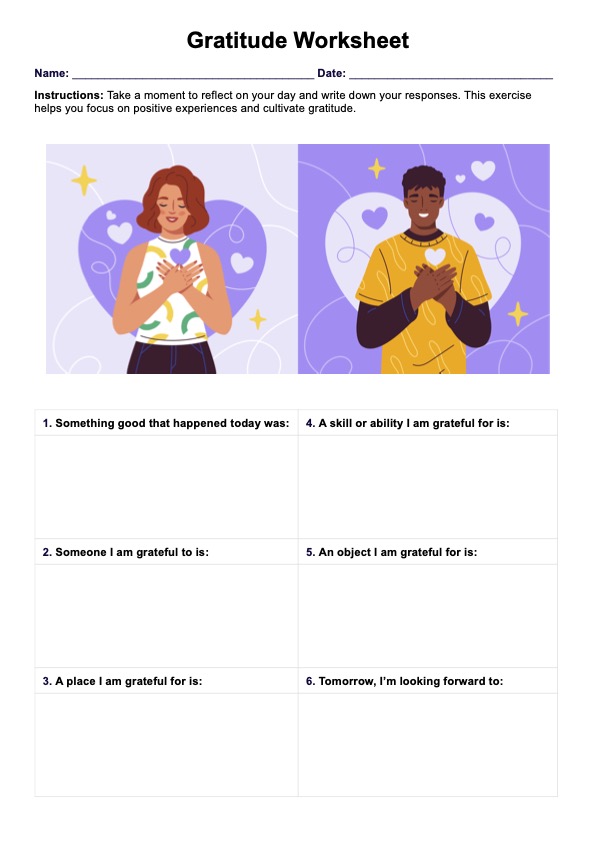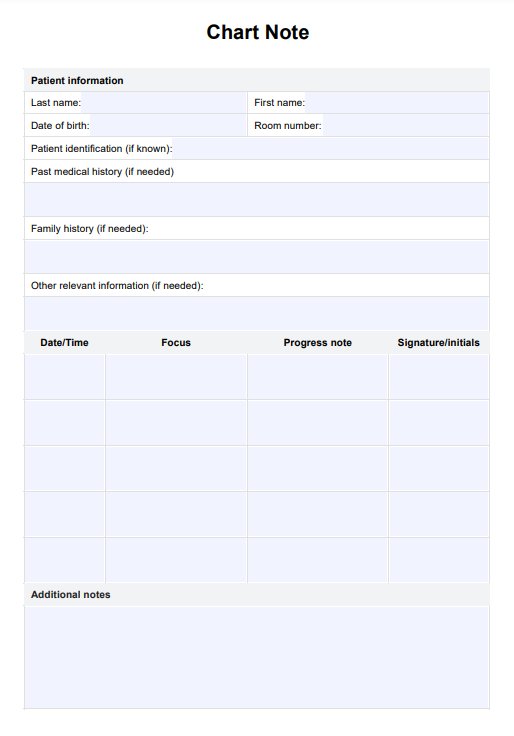Complicated Grief Disorder Test
Learn how the Complicated Grief Disorder Test can help diagnose complicated grief through this guide.


What is complicated grief?
Complicated grief, sometimes referred to as Prolonged Grief Disorder or Persistent Complex Bereavement Disorder, is a psychological condition characterized by intense grief that takes hold of a person for too long. This intense grief not only lasts for a long time, but it also severely impacts the person’s functioning, preventing them from carrying out their daily tasks well or at all, like work and household chores. Not only that, but this might even impact their relationships because they might start isolating themselves.
Grief is a natural response to loss. Everyone will experience loss in one way or another, whether it’s through the death of a loved one, the ending of a relationship, getting laid off from work, or losing your home to a natural disaster or fire, to mention a few examples.
When we grieve, it takes a while for people to work through it. Grief never really goes away, and it can resurface when we least expect it because of memories and painful reminders, but we grow around it over time. We become bigger containers for it, so if it does resurface, it’s easier to push it down and prevent it from overpowering us.
In “normal” grief, grief symptoms are intense for six months after a loss and should lessen over time, but for complicated grief? It’ll last far longer and can significantly disrupt a person’s daily life.
Complicated Grief Disorder Test Template
Complicated Grief Disorder Test Example
What are the signs of complicated grief?
If you’re handling a person who is grieving, you should be mindful of some specific signs and symptoms when talking to them, especially about their loss. Here are examples of signs and symptoms of complicated grief of a bereaved person:
- They have intense emotional pain that stems from their loss
- They have intense feelings and yearnings for a deceased loved one or a person they cut ties with
- They have trouble accepting the loss of someone or something
- They are preoccupied with thoughts about their loss
- They have intrusive thoughts or memories about someone or something they’ve lost
- They feel intense feelings of loneliness
- They developed a tendency to withdraw socially and isolate themselves
- They feel empty inside and feel that they’re meaningless
- There are changes in their personality
- They’ve become consumed with bitterness and feel anger towards themselves, others (family, friends, colleagues, etc.), and even a deceased person
- They’ve developed guilt and the tendency for self-blame
- There is a noticeable decline in their functioning, which can be seen through the sudden dip in the quality of work or total neglect for themselves, hygiene, and household matters
- They developed depression and anxiety
- They’ve started thinking lowly of themselves
- They’ve become emotionally numb
- They feel like they’ve lost direction in life
- They stop pursuing interests
What are the diagnostic criteria for complicated grief?
The Diagnostic and Statistical Manual of Mental Disorders - Fifth Edition Text Revision has established criteria for diagnosing complicated grief (named Prolonged Grief Disorder in the manual).
The basics of the criteria are:
- The deceased person must be close to the person being assessed and their death must have taken place at least 12 months ago
- On most days, to a clinically significant degree, they have an intense yearning or longing for the deceased
- On most days, to a clinically significant degree, they are preoccupied with thoughts and memories of the deceased (this may also include the circumstances of their death)
Besides these, they must have at least three of the eight symptoms we’re about to list. As a rule, these symptoms must be present to a clinically significant degree most days and must occur nearly every day for at least a month. Here they are:
- They feel that a part of themself has died since the death
- They have a marked sense of disbelief about the death
- They actively avoid reminders of the deceased person
- They feel intense emotional pain because of the death. Examples of such emotional pain include anger, bitterness, and sorrow
- They have difficulty reintegrating themselves into their relationships, problems engaging in conversation, or partaking in activities after the death
- They have emotional numbness
- They believe life is meaningless now that the deceased person is gone
- They’ve been feeling intense loneliness since the death
The last components of the criteria include the following:
- The bereaved person's grief disturbs their life immensely by causing clinically significant distress and impairing many essential areas of functioning,
- Their grief is so severe and has been prolonged for too long that it has exceeded the person’s specific social, cultural, and religious norms,
- And their symptoms are not better explained by other mental health conditions (e.g., major depression, PTSD) and the physiological effects of substances or medication.
How to use the Complicated Grief Test:
The Complicated Grief Test is a self-report assessment created by Holly G. Prigerson, Ph.D. and Paul K. Maciejewski, Ph.D. It’s meant to serve as a preliminary assessment of patients who potentially have complicated grief.
It’s simple to use. Mental healthcare professionals can use this for clinical work. Patients answering this test simply need to rate themselves by picking specific answer choices for each item, plus answer a few Yes or No questions.
Here are all the questions they need to answer:
- In the past month, how often have you felt yourself longing and yearning for [INSERT DECEASED PERSON’S NAME]? (Self-rating)
- In the past month, has the yearning been distressing to you or disruptive to your daily routine? (Yes or No)
- In the past month, to what extent have you had difficulty accepting the death? (Self-rating)
- In the past month, to what extent have you had difficulty trusting people? (Self-rating)
- In the past month, to what extent have you felt bitter over [INSERT DECEASED PERSON’S NAME]’s death? (Self-rating)
- Sometimes people who lose a loved one feel uneasy about moving on with their life. In the past month, to what extent do you feel that moving on (for example, making new friends, or pursuing new interests) would be difficult for you? (Self-rating)
- In the past month, to what extent have you felt emotionally numb or had difficulty connecting with others? (Self-rating)
- In the past month, to what extent do you feel that life is empty or meaningless without [INSERT DECEASED PERSON’S NAME]? (Self-rating)
- In the past month, to what extent do you feel that the future holds no meaning or purpose without [INSERT DECEASED PERSON’S NAME]? (Self-rating)
- In the past month, to what extent have you felt on edge, jumpy, or easily startled? (Self-rating)
- Has your grief resulted in impairment in your social, occupational, or other areas of functioning? For instance, does your grief make it difficult for you to perform your normal daily activities? (Yes or No)
- Have any of the above symptoms, including yearning and at least one Criterion B symptom, lasted for at least six months? (Yes or No)
How do you interpret the results of the Complicated Grief Test?
The Complicated Grief Test answer choices have number scores tied to them, but they’re not calculated.
All questions above are divided into four sections: Criterions A to D. As their names imply, each section has a specific criterion that must be met for the test to say that the person being assessed likely has complicated grief/prolonged grief disorder.
Criterion A is made up of the first two questions we listed above. If they answer “Every day” or “Several times every day” for the first question OR they answered “Yes” for the second question, they meet Criteria A. Either is needed for a Complicated Grief diagnosis.
Criterion B comprises the eight questions with self-rating answers listed above. Four out of eight questions must have been rated 4 or 5 to meet Criterion B.
Criterion C and D are made up of one question each. These are the last two questions listed earlier, and if they answer Yes for both, they meet Criterion C and Criterion D.
If they meet all four of these, then the possibility of complicated grief is likely. It would be best to conduct further tests and interviews and then cross-check everything with the latest edition of The Diagnostic and Statistical Manual of Mental Disorders before making a formal diagnosis.
After an official diagnosis has been made, a mental health professional can create a treatment plan that can involve social support and a kind of psychotherapy known as Complicated Grief Therapy. These should gradually help the patient deal with the suffering and sadness they feel over a loved one's death.
What are the benefits of using the Complicated Grief Test?
It’s a standardized assessment for potential cases of complicated grief.
One of the best qualities of the Complicated Grief Test is its set structure and criteria for assessing patients who potentially have Persistent Complex Bereavement Disorder. All patients who potentially have that disorder will be evaluated the same way. If they meet each Criterion on this test, then it’s considered that they likely have the disorder.
The last part of the test will have the healthcare professional indicate if the patient met each criterion. If they indicate yes, that counts as a complicated grief diagnosis, though we recommend still conducting further tests using other assessments for consistency.
It can help mental health professionals determine what goes into their treatment.
Remember that Criterion B requires respondents to rate four out of eight questions with an intensity of 4 to 5. Knowing which questions were rated with 4 or 5 can help professionals determine what aspects of their grief deserve more focus and their treatment plans should focus on helping the patient work through the problems that their prolonged grief disorder is causing them.
It can be used to monitor patients over time.
Suppose a patient got an official diagnosis for prolonged grief disorder and a treatment plan was implemented. You can schedule routine check-ups for them to check if they’re getting better over time. One way to check on them is to reuse this test. If their answers change and they show that their grief is lessening over time, then it’s safe to say the treatment plan is working.
If their answers remain the same or indicate a higher intensity for specific questions in Criterion B, adjust the plan and see if the changes work.
What are examples of support groups for complicated grief?
One way to work through complicated grief is to join support groups to show that one is not alone in one's suffering and some people can understand what one is going through.
Through similar or shared life experiences involving the loss of loved ones or something precious, people can discuss their emotional experiences like guilt, anxiety, anger, sadness, bitterness, and more. They can even share any negative thoughts they’ve had to deal with since the loss occurred. These groups offer non-judgmental spaces, which are sorely needed for such heavy discussions.
In the United States of America, examples of support groups one can join include GriefShare and The Compassionate Friends Non-Profit Organization for Grief. It’s best to refer your patients to support groups available in your location.
Online support groups that are worth checking out include First Candle, Suicide Grief Support, Actively Moving Forward, and MISS Foundation.
What are examples of evidence-based treatments for prolonged grief disorder?
Besides joining support groups, another way of helping a person work through grief is to take evidence-based treatments, which therapy and counseling can provide!
Complicated Grief Therapy
One example of psychotherapy that patients can take is Complicated Grief Therapy. Given that it’s grief therapy, the goal of this treatment is to help bereaved people healthily process their grief by working to instill in them the bravery and conviction to confront their grief.
By confronting their grief, you and the bereaved person will have the chance to adapt to the loss and find ways to help the patient move forward with their life and develop healthy coping mechanisms should their grief resurface down the line.
Mindfulness-based Grief Therapy
Mindfulness is a meditative practice that focuses on the present moment without reacting or being overwhelmed by what they’re becoming aware of. The present moment includes one’s surroundings, internal state, bodily sensations, thoughts, and feelings.
Mindfulness-based Grief Therapy is a form of psychotherapy that makes use of the principles of mindfulness and combines them with grief therapy techniques to help them become aware of and acknowledge all their emotions and thoughts associated with their grief without reacting or being overwhelmed by them. This gives them the chance to develop a better relationship with their grief and lessen the suffering they feel because of the loss.
If you’re a therapist who focuses on grief, we recommend checking out our grief worksheets so you can add them to your program. We also have a sample grief treatment plan. Check it out and see if you’d like to try it for one of your patients!
Commonly asked questions
It can be accomplished within 10 to 20 minutes.
Trained mental health professionals such as psychologists, psychiatrists, and clinical social workers can administer this test.
Yes. We do not recommend using this as the sole assessment, though. It would be best to use other assessments like the Inventory of Complicated Grief and the Prolonged Grief Disorder - PG 13, the latter of which was also created by the authors of the Complicated Grief Test.


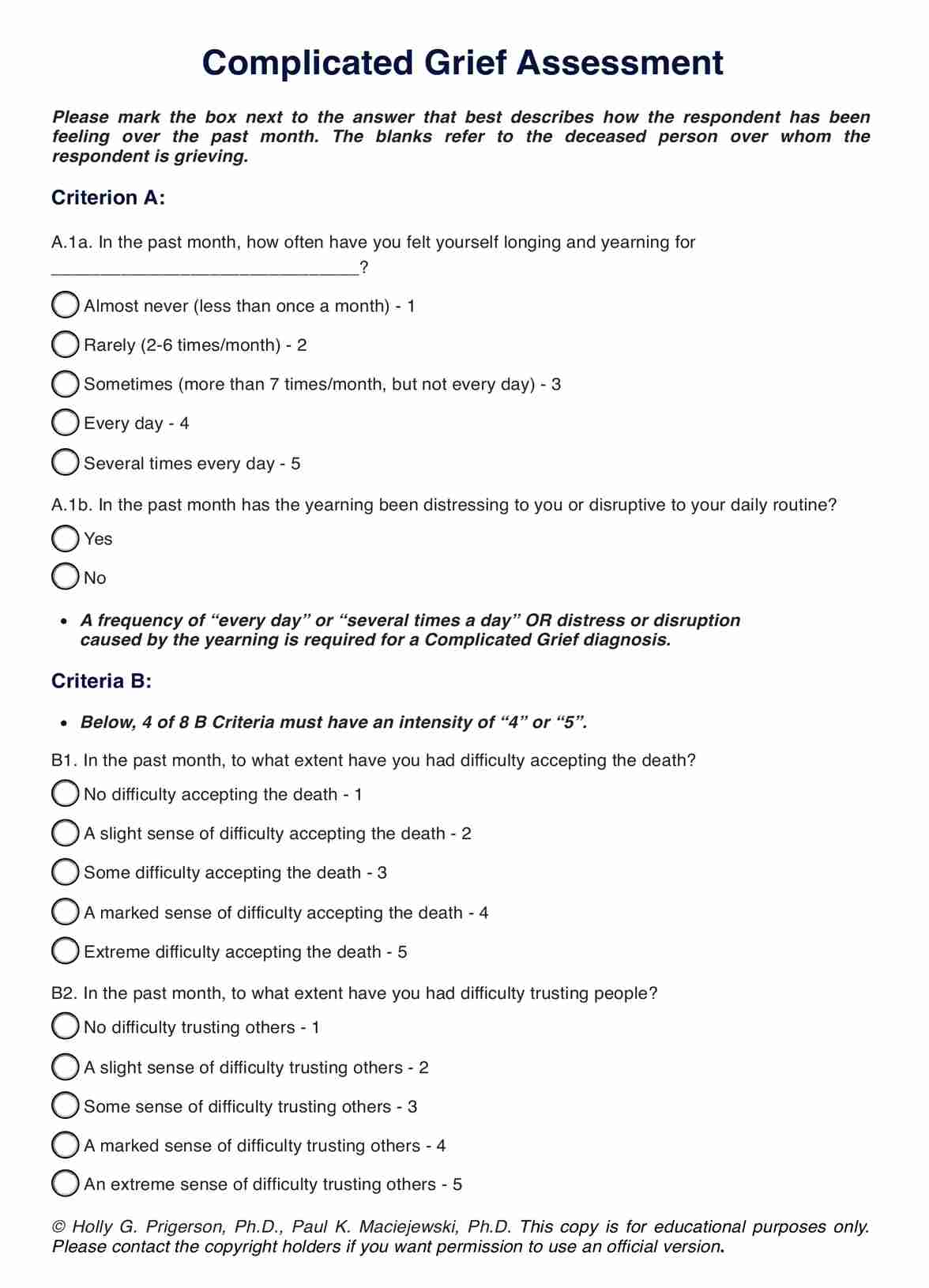
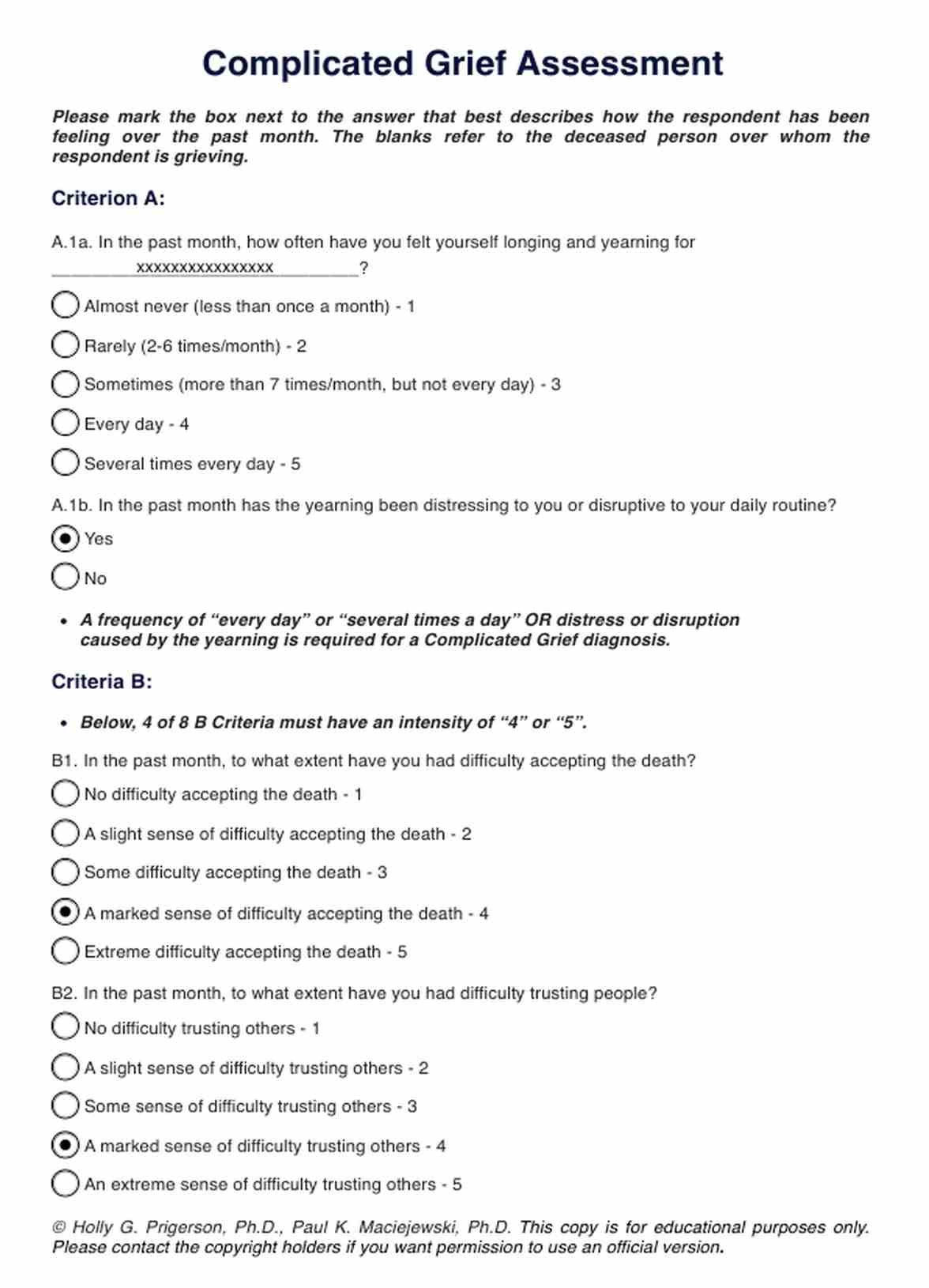

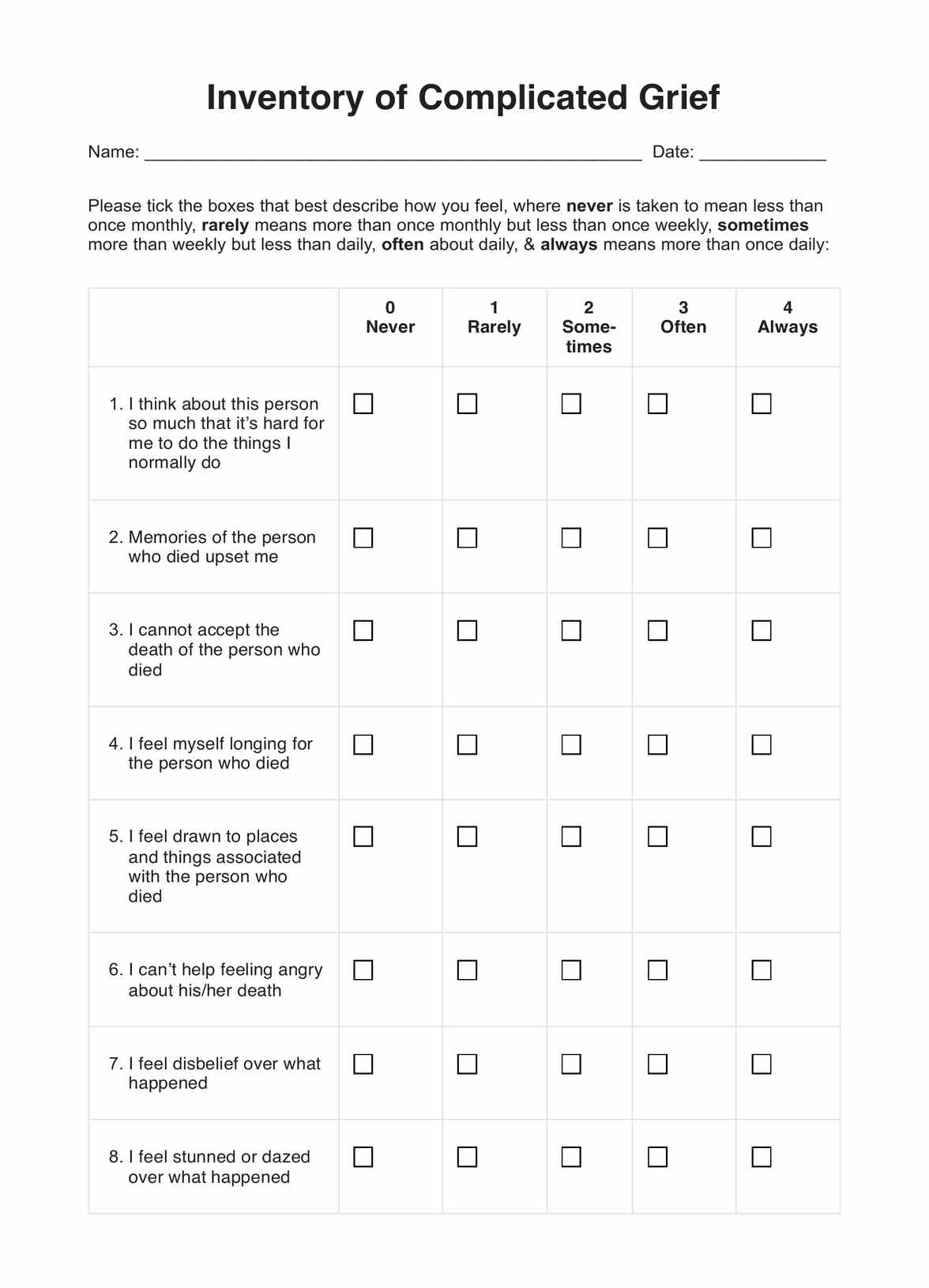
















-template.jpg)


























































































